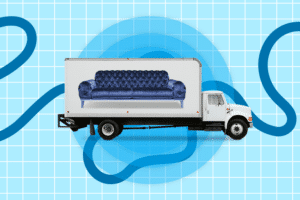The storage experts at SpareFoot continue our winter storage series with this quick guide for keeping your motorcycle in working order throughout the coldest months of the year. For boat storage tips, check out “How to Winterize Your Boat.”
If you’ve been watching too much Sons of Anarchy lately and somehow found yourself impulse-buying a brand new motorcycle (no judgment), make sure you prepare that bad boy for the onslaught of cold weather. Proper motorcycle storage is key during the winter months to ensure that your bike will run smoothly once you’re ready to ride again, especially if you live somewhere chilly like Minneapolis.
If you’re out of space in the garage, consider using a self-storage facility to keep your baby warm during the fall and winter. The best home for your motorcycle will be one that is dry, protected, and away from windows. It just so happens that a self-storage unit is the seamless combination of all three! Self-storage units are actually perfect options for vehicle storage: many offer drive-up access and additional security measures to ensure protection.
Many self-storage facilities have prerequisites for storing a vehicle, such as proving that it is in running condition. Once you’ve found a good self-storage facility for your bike, however, you’ll need to do some prep work before tucking it in for hibernation.
Preserve the engine:
Regardless of the length of inactivity, you need to make sure that your bike is ready for use in the future after however many weeks or months of storage. Change the engine oil and the filter to help preserve your engine. Fill the gas up to full (do not overfill! The correct amount is usually when the liquid hits the bottom of the filler neck) and use a fuel-stabilizer to prevent moisture from building
up in half-empty tanks.
Prevent rusting and corrosion:
Keep water out of the pipes! Spray some WD40 into the exhaust pipes, muffler ends, and drain holes, as well as all other metal surfaces to prevent rusting. Keep additional moisture out by stuffing plastic bags into muffler holes and covering them with another plastic bag. Waxing is also recommended, since it acts as a barrier against potential moisture.
Protect the battery:
Remove the battery from your motorcycle before putting it into storage. Charge your battery at least every two weeks to make sure that it doesn’t sulfate.
Check fluids and tires:
Change the brake and hydraulic clutch fluid if you haven’t done so in a while. These fluids absorb moisture and may cause corrosion in the long run. Also check the tire pressure and make sure your front and rear tires are filled to the maximum recommended pressure. Pump them up throughout the winter to keep your tires healthy and to prevent the rubber from freezing (if it freezes, it cracks!). If you’re worried about the ground freezing, use wood blocks to keep the tires elevated and away. Finally, cover your bike to keep dust off, but make sure there’s no moisture trapped underneath, as this will lead to corrosion.
Inspect everything before your first spring ride:
Congratulations, you’ve braved the winter months and so has your motorcycle! Before you go speeding off into the warm sunset with the light of your life, make sure you do a thorough check of all the fluid levels and assess anything potentially wrong with the bike. Fill the tire pressures back to normal as well, and be careful—your bike won’t be rusty after the long winter, but your riding skills
might be.
Guide Written by Jenny Zhang, SpareFoot


